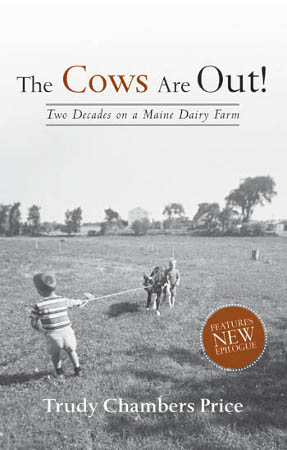
The Cows Are Out
 The
Cows Are Out by
Trudy Chambers Price is a good farm memoir to read on a rainy
day. The author, her husband, and their two sons spent 23 years
on a moderate-sized dairy farm (25 to 75 Holsteins) in Maine. The
story itself is very engaging, aided by the frequent family photos and
the author's pleasant style, but as Mom told me when she lent me the
book, "It's the wrong kind of dairy farm!"
The
Cows Are Out by
Trudy Chambers Price is a good farm memoir to read on a rainy
day. The author, her husband, and their two sons spent 23 years
on a moderate-sized dairy farm (25 to 75 Holsteins) in Maine. The
story itself is very engaging, aided by the frequent family photos and
the author's pleasant style, but as Mom told me when she lent me the
book, "It's the wrong kind of dairy farm!"
Mom was coming fresh
from reading Folks,
This Ain't Normal,
so she was struck by the amount of time the Prices' cows spent in
confinement on concrete floors. From what I read, though, dairy
cows are a whole 'nother ball game, and it takes a lot of extremely
careful planning to raise them on pasture alone. The Prices did
have lots of grazing area they turned the cows into in the summer, and
I suspect stockpiled
winter grazing
hadn't hit the forefront during the sixties, seventies, and eighties,
so folks didn't have any other option than to feed their cows hay in
the barn all winter.
While I'm willing to
give the operation a pass on the confinement score, I do think it
should be read as a cautionary tale about debt. First the couple
went into debt to buy the farm, then they went further into debt to
purchase machinery (and yet more machinery as time wore on). Two
years after moving to the land, the author had to start teaching school
to pay the bills, and it was clear that even after 23 years, they had
yet to break even.
This cycle of debt is
par for the course in mainstream American farming today, but I think
it's also what drives the little guy out and turns our farmland over to
mammoth agribusinesses. In the Prices' shoes, I'd like to say
that Mark and I would have thought outside the box and dreamed up
value-added products so we could keep equipment purchases to a minimum
and make a living wage, but it's hard to think straight if you're up at
3:30 every morning to do the milking.
Want more in-depth information? Browse through our books.
Or explore more posts by date or by subject.
About us: Anna Hess and Mark Hamilton spent over a decade living self-sufficiently in the mountains of Virginia before moving north to start over from scratch in the foothills of Ohio. They've experimented with permaculture, no-till gardening, trailersteading, home-based microbusinesses and much more, writing about their adventures in both blogs and books.
Want to be notified when new comments are posted on this page? Click on the RSS button after you add a comment to subscribe to the comment feed, or simply check the box beside "email replies to me" while writing your comment.

It is my impression that a lot of people in the US in general buy too much with borrowed money.
It seems that 70% of car purchases in the US involve a loan. Given that the value of a car depreciates by 11% the minute you drive off the dealer's parking lot, and another 15-25% year year for the first five years, you'd have to be crazy to loan money for a new car.
And the average cradit card debt for families having a credit card is a staggering $15800, with an average interest rate of 13%.
WI had 1000K dairy farms 50 yrs ago. Today there are 12K. Like any production endeavor, there's the economy of scale. Add to that the burden of needless regulations as mentioned above, and the small guy has trouble making a profit.
A homestead with an acre of decent pasture could support a single milk cow. Borrow a bull or AI each year and she'll produce plenty of milk for your non-commercial purposes. Keep the calf with her to do most of the work (and later provide you with beef) and you could just get the few gallons a week you need.